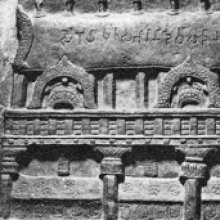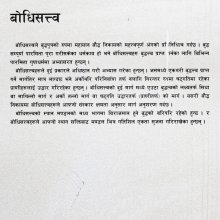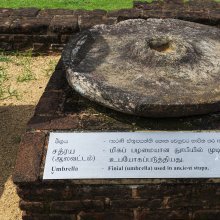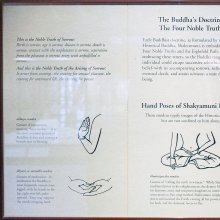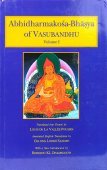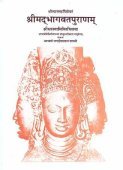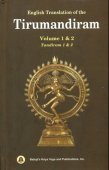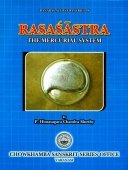Path, Paṭh: 12 definitions
Introduction:
Path means something in Hinduism, Sanskrit, Hindi. If you want to know the exact meaning, history, etymology or English translation of this term then check out the descriptions on this page. Add your comment or reference to a book if you want to contribute to this summary article.
Images (photo gallery)
(+6 more images available)
In Hinduism
Yoga (school of philosophy)
Source: ORA: Amanaska (king of all yogas): A Critical Edition and Annotated Translation by Jason Birch1) The Pathways (of vitality) are denoted by the Sanskrit term Nāḍi, according to the Amanaska Yoga treatise dealing with meditation, absorption, yogic powers and liberation.—Accordingly, as Īśvara says to Vāmadeva: “In the Cakras, such as Mūlādhāra, in the pathways (nāḍi) [of vitality], such as Suṣumnā, and in the vital airs, such as Prāṇa, the highest reality is not located. [...]”.
2) The Path (i.e., of Suṣumnā) can be defined by the Sanskrit term Mārga, according to the Amanaska Yoga.—Accordingly, as Īśvara says to Vāmadeva: “[...] [Now], I shall define the nature of that highest, mind-free absorption which arises for those devoted to constant practice. [...] By means of an absorption for a fourth of a Kalā (i.e., ninety breaths), [Kuṇḍalinī] who flows along the path (mārga) [called] Suṣumnā, goes partially through [this] path [which is] at the back of the [Yogin's] body. [...]”.

Yoga is originally considered a branch of Hindu philosophy (astika), but both ancient and modern Yoga combine the physical, mental and spiritual. Yoga teaches various physical techniques also known as āsanas (postures), used for various purposes (eg., meditation, contemplation, relaxation).
Languages of India and abroad
Sanskrit dictionary
Source: DDSA: The practical Sanskrit-English dictionaryPaṭh (पठ्).—1 P. (paṭhati, paṭhita)
1) To read or repeat aloud, recite, rehearse; यः पठेच्छृणुयादपि (yaḥ paṭhecchṛṇuyādapi).
2) To read or recite to oneself; study, peruse; इत्येतन्मानवं शास्त्रं भृगुप्रोक्तं पठन् द्विजः (ityetanmānavaṃ śāstraṃ bhṛguproktaṃ paṭhan dvijaḥ) Manusmṛti 15.126;4.98; नाक्षराणि पठता किमपाठि (nākṣarāṇi paṭhatā kimapāṭhi) N.5.121.
3) To invoke (as a deity).
4) To cite, quote, mention (as in a book); एतदिच्छाम्यहं श्रोतुं पुराणे यदि पठ्यते (etadicchāmyahaṃ śrotuṃ purāṇe yadi paṭhyate) Mb.
5) To declare, describe, express; भार्या च परमो ह्यर्थः पुरुषस्येह पठ्यते (bhāryā ca paramo hyarthaḥ puruṣasyeha paṭhyate); Mb.
6) To teach.
7) To learn from (with abl.). -Caus. (pāṭhayati-te)
1) To cause to read aloud.
2) To teach, instruct; राजन् राजसुता न पाठयति माम् (rājan rājasutā na pāṭhayati mām) K. P.1. -Desid. (pipaṭhiṣati) To wish to recite &c. -With परि (pari) to mention, declare. (-Caus.) to teach; तौ सर्वविद्याः परिपाठितौ (tau sarvavidyāḥ paripāṭhitau) Uttararāmacarita 2.
--- OR ---
Path (पथ्).—I. 1 P. (pathati) To go, move. -II. 1 U. (pāthayati-te) To throw, cast.
Source: Cologne Digital Sanskrit Dictionaries: Shabda-Sagara Sanskrit-English DictionaryPaṭh (पठ्).—[paṭha] r. 1st. cl. (paṭhati) To speak articulately, to declaim, to recite or read. bhvā0 para0 saka0 seṭ .
--- OR ---
Path (पथ्).—[patha] r. 1st. cl. (pathati) to go, to move. r. 10th. cl. (pāthayati) To throw, to cast, to despatch or send; (i) pathi, r. 1st. and 10th. cls. (panthati panthayati) To go, to proceed, to travel. gatau bhvā0 para0 saka0 seṭ . vā curā ubha0 pakṣe bhvā0 para0 saka0 seṭ idit .
Source: Cologne Digital Sanskrit Dictionaries: Benfey Sanskrit-English DictionaryPaṭh (पठ्).— (probably a [denominative.] derived from paṣṭa for spaṣṭa; cf. paśya for spaśya), i. 1, [Parasmaipada.] (in epic poetry also [Ātmanepada.]) 1. To speak distinctly, to recite, Mahābhārata 2, 1154. 2. To invoke, [Harivaṃśa, (ed. Calc.)] 12561. 3. To read, to study, [Mānavadharmaśāstra] 4, 98. 4. To mention, Mahābhārata 3, 1483. 5. To declare, [Suśruta] 2, 260, 16. 6. To learn from (abl.), [Bhāgavata-Purāṇa, (ed. Burnouf.)] 9, 22, 37. [Causal.] pāṭhaya, 1. To teach one to talk, [Hitopadeśa] [prologue.] [distich] 43. 2. To teach one to read, [Bhāgavata-Purāṇa, (ed. Burnouf.)] 7, 5, 2. 3. To cause to read, [Pañcatantra] 5, 11. 4. To teach, [Bhāgavata-Purāṇa, (ed. Burnouf.)] 7, 5, 2. Frequent. pāpaṭhya, To recite repeatedly, [Kathāsaritsāgara, (ed. Brockhaus.)] 37, 73.
— With the prep. anu anu, To say after one, to repeat, [Bhāgavata-Purāṇa, (ed. Burnouf.)] 7, 5, 3.
— With abhi abhi, abhipaṭhita, Called, named, [Suśruta] 2, 310, 18.
— With pari pari, 1. To mention, Mahābhārata 1, 2020. 2. To declare, 3, 14192.
— With pra pra, To recite loudly, [Harivaṃśa, (ed. Calc.)] 9591.
— With sam sam, To read, [Mānavadharmaśāstra] 4, 98. Comp. pteple. of the fut. pass. of the [Causal.] a-saṃpāṭhya, One with whom nobody is allowed to read (or to pray), [Mānavadharmaśāstra] 9, 238.
--- OR ---
Path (पथ्).—i. 1, [Parasmaipada.] To go. † i. 10, pāthaya, To throw (v. r.).
--- OR ---
Path (पथ्).—see pathin.
Source: Cologne Digital Sanskrit Dictionaries: Cappeller Sanskrit-English DictionaryPaṭh (पठ्).—paṭhati (paṭhate) read aloud, recite, rehearse; teach, mention; repeat to one’s self, study, learn from ([ablative]). [Causative] pāṭhayati teach to talk or read, teach i.[grammar] (2 [accusative]); read, peruse. [Intensive] pāpaṭhīti & pāpaṭhyate recite often, read or study diligently.
--- OR ---
Path (पथ्).—([nominative] panthās) path, road, course, way, manner; a cert. hell.
— panthānaṃ dā give the way to, go out of the way of ([genetive]). pathi in the way, on the journey; pathānena in this way or manner.
Source: Cologne Digital Sanskrit Dictionaries: Monier-Williams Sanskrit-English Dictionary1) Paṭh (पठ्):—[class] 1. [Parasmaipada] ([Dhātupāṭha ix, 45]) paṭhati (te, [Mahābhārata] etc.; [perfect tense] papāṭha, [ib.]; [Aorist] apAWit [grammar]; [future] paṭhiṣyati, paṭhitā, [ib.]; [indeclinable participle] paṭhitvā, [Kāvya literature]),
—to read or repeat aloud, to recite, rehearse, [Taittirīya-āraṇyaka; Mahābhārata] etc.;
—to repeat or pronounce the name of a god, to invoke ([accusative], also with nāmabhis), [Mahābhārata; Harivaṃśa];
—to read or repeat or recite to one’s self, to peruse, study, [Manu-smṛti; Rāmāyaṇa; Bhāgavata-purāṇa; Hitopadeśa];
—to teach, cite, quote, mention, express, declare, [Lāṭyāyana; Mahābhārata; Bhāgavata-purāṇa; Suśruta];
—to learn from ([ablative]), [Bhāgavata-purāṇa] :—[Passive voice] paṭhyate, to be read or recited or taught or mentioned etc., [Mahābhārata; Harivaṃśa] :—[Causal] pāṭhayati ([Aorist] apīpaṭhat, [Pāṇini 7-4, 1 [Scholiast or Commentator]]; [future] pāṭhayiṣyati, [Kathāsaritsāgara]; [Passive voice] pāṭhyate, [Hitopadeśa]),
—to cause or teach to speak or read, to teach, instruct in (with double [accusative] [Kāśikā-vṛtti on Pāṇini 1-4, 52]);
—to read, recite, [Kathāsaritsāgara] :—[Intensive] pāpaṭhīti, pāpaṭhyate, to recite often or repeatedly, [Kathāsaritsāgara];
—to read or study diligently, [Varāha-mihira]
2) Path (पथ्):—(cf. √panth) [class] 1. [Parasmaipada] pathati, to go, move;
2) —to fly, [Suparṇādhyāya; Dhātupāṭha xx, 17] :—[Causal] pāthayati, to throw, send ([xxxii, 20] [varia lectio] for pṛth and prath).
Source: Cologne Digital Sanskrit Dictionaries: Yates Sanskrit-English DictionaryPaṭh (पठ्):—paṭhati 1. a. To speak, to articulate, to declaim, to read.
Source: DDSA: Paia-sadda-mahannavo; a comprehensive Prakrit Hindi dictionary (S)Paṭh (पठ्) in the Sanskrit language is related to the Prakrit word: Paḍha.
[Sanskrit to German]
Sanskrit, also spelled संस्कृतम् (saṃskṛtam), is an ancient language of India commonly seen as the grandmother of the Indo-European language family (even English!). Closely allied with Prakrit and Pali, Sanskrit is more exhaustive in both grammar and terms and has the most extensive collection of literature in the world, greatly surpassing its sister-languages Greek and Latin.
Hindi dictionary
Source: DDSA: A practical Hindi-English dictionary1) Path in Hindi refers in English to:—(nm) a path, way, course, route; -[kara] toll; ~[gami] a traveller, wayfarer; ~[darshaka/pradarshaka] a guide; leader; -[pradarshana] guidance..—path (पथ) is alternatively transliterated as Patha.
2) Path in Hindi refers in English to:—(nm) a lesson; text; recital/recitation; reading, study; ~[carya] syllabus; -[bheda] different reading, varying version, variant; ~[vijnana] textual criticism; -[shodhana] emendation, correction/rectification (of the text); -[samshodhana] emendation; —[padhana] to teach lesson; to initiate; to instigate someone into vile ways; —[padhana, ulata] to misinstruct, to instigate into vile ways; —[sikhana] to learn a lesson from..—path (पाठ) is alternatively transliterated as Pāṭha.
...
See also (Relevant definitions)
Starts with (+775): Pata, Pata-pankayamalai, Pata-petarokam, Patacakai, Patacakkaram, Patacalakam, Patacam, Patacan, Patacanam, Patacaram, Patacayalam, Pataccariyai, Pataccetam, Patacevai, Patacutti, Patai, Pataipatai, Pataittuvilu, Patakai, Patakaicottikam.
Ends with (+19): Anupath, Apath, Apipath, Atipath, Avapath, Bhuspath, Eightfold Path, Fivefold-path, Footpath, Fourfold-path, Homeopath, Ishtakapath, Janpath, Kalipath, Kupath, Masturipath, Middle Path, Ninefold-path, Noble Eightfold Path, Paripath.
Full-text (+4180): Patha, Pathin, Marga, Magga, Sanmarga, Pitriyana, Paripatha, Adhvan, Pipathish, Pathaka, Prapathaka, Pathadosha, Anupath, Nipathiti, Paripath, Samyakpatha, Nipathita, Sixfold-path, Devayana, Aryashtangamarga.
Relevant text
Search found 481 books and stories containing Path, Paṭh, Pathway, Paath; (plurals include: Paths, Paṭhs, Pathwaies, Paaths). You can also click to the full overview containing English textual excerpts. Below are direct links for the most relevant articles:
The Shiva Purana (by J. L. Shastri)
Chapter 17 - The rules governing Śaivite initiation < [Section 7.2 - Vāyavīya-saṃhitā (2)]
Chapter 7 - Pathway to Hell and the Emissaries of Yama < [Section 5 - Umā-Saṃhitā]
Chapter 29 - The analysis of Vāgartha (vāg-artha) < [Section 7.1 - Vāyavīya-saṃhitā (1)]
Maha Prajnaparamita Sastra (by Gelongma Karma Migme Chödrön)
I. Knowledge of the paths < [VI. Acquiring the knowledges of the paths and the aspects of the paths]
II. Knowledge of the paths leading to omniscience < [VII. Winning omniscience and the knowledge of all the aspects]
Preliminary note on acquiring the knowledges of the paths < [VI. Acquiring the knowledges of the paths and the aspects of the paths]
Shrimad Bhagavad-gita (by Narayana Gosvami)
Verse 8.26 < [Chapter 8 - Tāraka-brahma-yoga (the Yoga of Absolute Deliverance)]
Verse 8.23 < [Chapter 8 - Tāraka-brahma-yoga (the Yoga of Absolute Deliverance)]
Verse 8.27 < [Chapter 8 - Tāraka-brahma-yoga (the Yoga of Absolute Deliverance)]
Brahma Sutras (Nimbarka commentary) (by Roma Bose)
Brahma-Sūtra 3.1.17 (correct conclusion) < [Adhikaraṇa 3 - Sūtras 12-21]
Brahma-Sūtra 4.2.20 < [Adhikaraṇa 11 - Sūtras 19-20]
Brahma-Sūtra 4.3.1 < [Adhikaraṇa 1 - Sūtra 1]
Where Was I Wrong? < [January – March, 1997]
The Path < [July – September, 2007]
The Two Paths < [January, 1928]
Brahma Sutras (Ramanuja) (by George Thibaut)
Sutra 4.2.20 < [Fourth Adhyaya, Second Pada]
Sutra 3.1.17 < [Third Adhyaya, First Pada]
Sutra 4.3.2 < [Fourth Adhyaya, Third Pada]
Related products
(+13 more products available)
